Centropyge
Centropyge is a genus of ray-finned fish, marine angelfish belonging to the family Pomacanthidae found in the Atlantic, Indian and Pacific Ocean.[2] These species do not exceed 15 cm in length and live in haremic structures with one dominant male and multiple females.[2] Although it is hard to identify their gender; females are often shorter and more round finned. Like many other reef fish and all marine angelfish, the species in this genus are protogynous hermaphrodite, meaning that they start their adult lives as females and the dominant individual in a group can change to a male within days. A reversal of this sex change is possible if the social status of the individual changes, it is however a process that requires much more time.[3]
| Centropyge | |
|---|---|
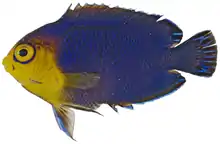 | |
| Centropyge argi | |
.jpg.webp) | |
| Centropyge loriculus | |
| Scientific classification | |
| Kingdom: | Animalia |
| Phylum: | Chordata |
| Class: | Actinopterygii |
| Order: | Perciformes |
| Family: | Pomacanthidae |
| Genus: | Centropyge Kaup, 1860 |
| Type species | |
| Holacanthus tibicen | |
| Synonyms[1] | |
| |
In aquaria
This genus prefer matured reef tanks due to the usually high water quality and the often used "live rock". In nature most species feed on algae, sponges and small benthic invertebrates. Having an abundance of well cured live rock will help to supplement their diet.[4] This is also in the interest of the aquarist, as underfed Centropyge angels may nip at corals and sessile invertebrates.[5] The difficulty of keeping varies from species to species, as does their rarity and correspondingly their price. These species are social that live in loose groups in the wild. So if multiple this genus is kept to a tank, they will establish a pecking order. To reduce the stresses of establishing the dominance in the group it is wise to choose semi-adult specimens or specimens of different size. Dwarf angels can be quite shy initially, hiding in corals, caves and crevices but become more outgoing when they have established their territory - if they are kept with appropriate tank mates and in appropriately sized tanks.[6]
Species
There are currently 35 recognized species in this genus:[2]
| Image | Scientific name | Common name | Distribution |
|---|---|---|---|
%252C_Waikiki_Aquarium.JPG.webp) | Centropyge abei G. R. Allen, Young & P. L. Colin, 2006 | Abe's pygmy angelfish | western Pacific Ocean, amongst the islands of Indonesia and Palau |
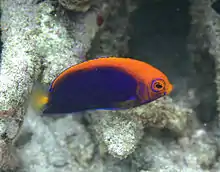 | Centropyge acanthops (Norman, 1922) | Orange-back pygmy angelfish | east coast of Africa, |
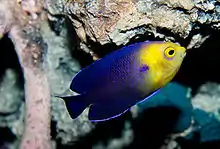 | Centropyge argi Woods & Kanazawa, 1951 | Cherub pygmy angelfish | the Caribbean and Gulf of Mexico, North to North Carolina. |
| Centropyge aurantia J. E. Randall & Wass, 1974 | Golden pygmy angelfish | the western Pacific Ocean: Indonesia and the Great Barrier Reef. | |
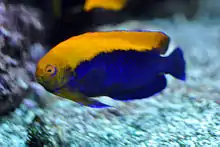 | Centropyge aurantonotus W. E. Burgess, 1974 | Flame-back pygmy angelfish | southern Caribbean Sea and the coastal waters of Brazil |
 | Centropyge bicolor (Bloch, 1787) | Bicolor pygmy angelfish | Indo-Pacific region: including East Africa, Southern Japan, Australia, and even Fiji. |
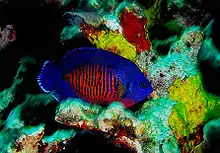 | Centropyge bispinosa (Günther, 1860) | Two-spined pygmy angelfish | Indo-Pacific |
%252C_Waikiki_Acquarium.JPG.webp) | Centropyge boylei Pyle & J. E. Randall, 1992 | Peppermint pygmy angelfish | eastern-central Pacific around the Cook Islands and Rarotonga |
| Centropyge cocosensis K. N. Shen, C. W. Chang, Delrieu-Trottin & Borsa, 2016 | Cocos pygmy angelfish [7] | Eastern Indian Ocean: Cocos (Keeling) Islands and Christmas Island. | |
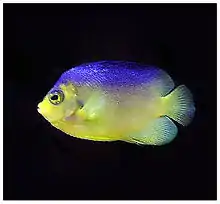 | Centropyge colini Smith-Vaniz & J. E. Randall, 1974 | Cocos-Keeling angelfish | Indo-west Pacific Ocean, including around the Cocos (Keeling) Islands |
| Centropyge debelius Pyle, 1990 | Blue Mauritius pygmy angelfish | Western Indian Ocean: Mauritius, Réunion, and the Aldabra Group (Seychelles). | |
| Centropyge deborae K. N. Shen, H. C. Ho & C. W. Chang, 2012 | Blue velvet pygmy angelfish [8] | Fiji | |
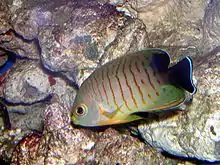 | Centropyge eibli Klausewitz, 1963 | Black-tail pygmy angelfish | the Indo-Pacific. |
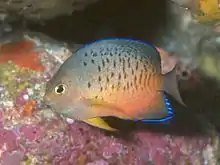 | Centropyge ferrugata J. E. Randall & W. E. Burgess, 1972 | Rusty pygmy angelfish | Western Pacific Ocean |
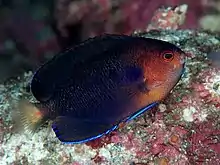 | Centropyge fisheri (Snyder, 1904) | Orange pygmy angelfish | Hawaii. |
.jpg.webp) | Centropyge flavipectoralis J. E. Randall & Klausewitz, 1977 | Yellow-fin pygmy angelfish | Indian Ocean |
.jpg.webp) | Centropyge flavissima (G. Cuvier, 1831) | Lemon-peel pygmy angelfish | Indo-Pacific region |
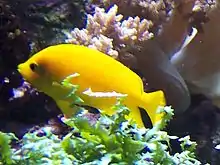 | Centropyge heraldi Woods & L. P. Schultz, 1953 | Yellow pygmy angelfish [7] | Pacific Ocean |
| Centropyge hotumatua J. E. Randall & D. K. Caldwell, 1973 | Black-ear pygmy angelfish | Eastern Pacific: Austral (including Rapa), Pitcairn and Easter islands. | |
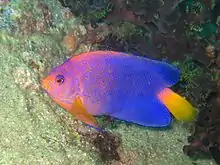 | Centropyge interrupta (S. Tanaka (I), 1918) | Japanese pygmy angelfish | Ogasawara Islands south of Japan. |
| Centropyge joculator Smith-Vaniz & J. E. Randall, 1974 | Yellow-head pygmy angelfish | Eastern Indian Ocean: Cocos and Christmas Islands. | |
.jpg.webp) | Centropyge loriculus (Günther, 1874) | Flame pygmy angelfish | reefs of Oceania, most common in Marshall, Line, and Cook Islands |
| Centropyge multicolor J. E. Randall & Wass, 1974 | Multicolor pygmy angelfish | Pacific Ocean | |
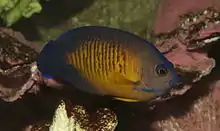 | Centropyge multispinis (Playfair, 1867) | Dusky pygmy angelfish | tropical waters of the Indo-Pacific |
| Centropyge nahackyi Kosaki, 1989 | Nahacky's pygmy angelfish | Eastern Central Pacific: Johnston Atoll. Strays reported from the Hawaiian Islands. | |
| Centropyge narcosis Pyle & J. E. Randall, 1993 | Narc pygmy angelfish | Cook Islands | |
| Centropyge nigriocellus Woods & L. P. Schultz, 1953 | Black-spot pygmy angelfish | Pacific Ocean near American Samoa; Cook Islands; Guam; Kiribati (Phoenix Is.); Marshall Islands; Micronesia, Federated States of ; Nauru; New Caledonia; Northern Mariana Islands; Papua New Guinea; Samoa; Tokelau; Tuvalu; United States Minor Outlying Islands (Howland-Baker Is., Johnston I., US Line Is.) | |
| Centropyge nox (Bleeker, 1853) | Midnight pygmy angelfish | Western Pacific: Ryukyu Islands to Indonesia, the Solomon Islands, the Great Barrier Reef and New Caledonia | |
 | Centropyge potteri (D. S. Jordan & Metz, 1912) | Russet pygmy angelfish | Johnston Atoll and the Hawaiian Islands in the central Pacific Ocean |
| Centropyge resplendens Lubbock & Sankey, 1975 | Resplendent pygmy angelfish | Ascension Island | |
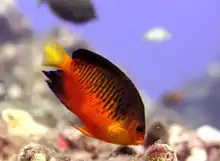 | Centropyge shepardi J. E. Randall & Yasuda, 1979 | Mango pygmy angelfish | Northern Marianas Islands, Guam, and the Ogasawara Islands. |
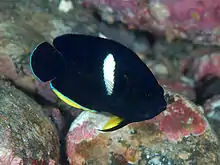 | Centropyge tibicen (G. Cuvier, 1831) | Key-hole pygmy angelfish | Indo-Pacific |
| Centropyge venusta (Yasuda & Tominaga, 1969) | Purple-mask pygmy angelfish | Western Pacific | |
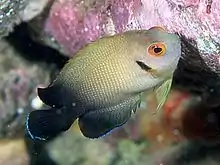 | Centropyge vrolikii (Bleeker, 1853) | Pearl-scale angelfish | Indo-West Pacific area |
| Centropyge woodheadi Kuiter, 1998 | Black-fin pygmy angelfish [7] | Southwestern Pacific: from the Great Barrier Reef to the Gambier archipelago. | |
References
- Eschmeyer, William N.; Fricke, Ron & van der Laan, Richard (eds.). "Genera in the family Pomacanthidae". Catalog of Fishes. California Academy of Sciences. Retrieved 14 January 2021.
- Froese, Rainer and Pauly, Daniel, eds. (2016). Species of Centropyge in FishBase. October 2016 version.
- Hioki, S. & Suzuki, K. (1996): Sex changing from male to female on the way of protogynous process in three Centropyge angelfishes (Pomacanthidae: Teleostei). Bulletin of the Institute of Oceanic Research and Development, Tokai University, 17: 27–34.
- Thomasser, A. Reef Safari! Keeping Multibarred Angelfish. WetWebMedia.
- Hauter, S. & Hauter, D. (2016): Reef Tank Safe Angelfish. Saltaquarium.
- Fenner, R. Perfect Little Angels, Genus Centropyge. WetWebMedia.
- Shen, K.-N., Chang, C.-W., Delrieu-Trottin, E. & Borsa, P. (2016): Lemonpeel (Centropyge flavissima) and yellow (C. heraldi) pygmy angelfishes each consist of two geographically isolated sibling species. Marine Biodiversity, 47 (3): 831-845.
- Shen, K.-N., Ho, H.-C. & Chang, C.-W. (2012): The Blue Velvet Angelfish Centropyge deborae sp. nov., a New Pomacanthid from the Fiji Islands, Based on Genetic and Morphological Analyses. Zoological Studies, 51 (3): 415-423.
